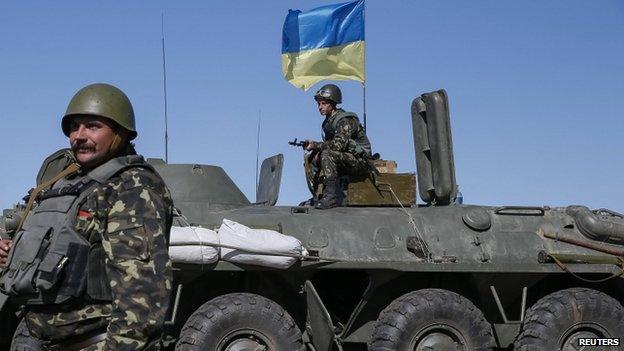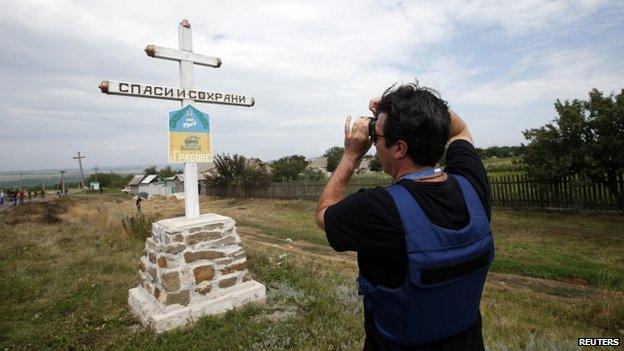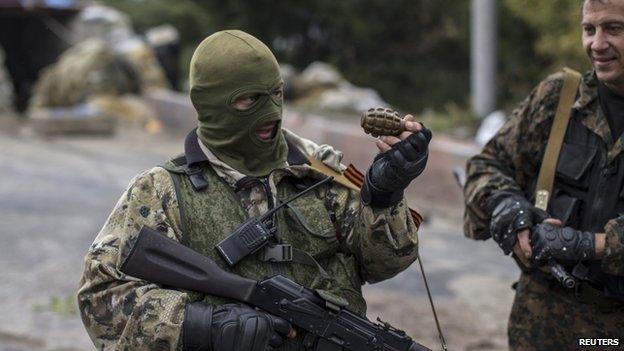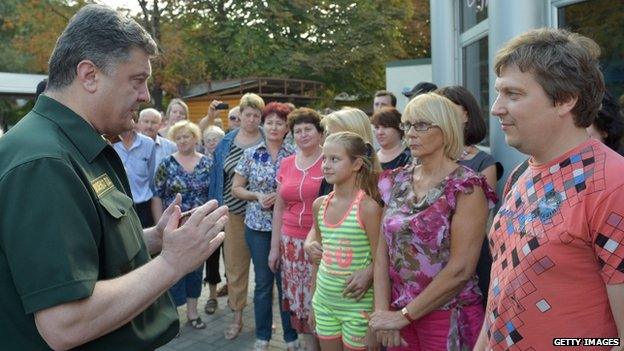Ukraine ceasefire: The 12-point plan
- Published

Ukrainian forces suffered major setbacks in fighting just before the truce
Heavy fighting in eastern Ukraine has scuppered a ceasefire deal agreed between Ukraine and pro-Russian rebels in Minsk on 5 September.
But the 12-point plan may still form the basis of a new deal, if diplomacy spearheaded by France and Germany this week bears fruit.
What was in the 12-point plan agreed in the Belarusian capital?
1. An immediate bilateral ceasefire
The number of casualties fell sharply in the days immediately after the ceasefire. But within weeks the fighting had intensified again, especially the battle for Donetsk airport.
Before the ceasefire, the numbers of combatants killed in fighting could reach dozens each day.
2. Monitoring and verification of the ceasefire
The Organisation for Security and Co-operation in Europe (OSCE) said dozens of its monitors have been tracking the ceasefire in Donetsk and Luhansk regions.
However, the OSCE has been unable to check the many convoys of Russian trucks that have entered rebel-held areas of eastern Ukraine. There are suspicions that arms were brought in as well as humanitarian supplies.

An OSCE monitor at the crash site of Malaysia Airlines Flight MH17 in the Donetsk region
3. Decentralisation of power
Soon after the ceasefire deal Ukrainian President Petro Poroshenko persuaded parliament to adopt a law on "temporary self-rule" for parts of the Donetsk and Luhansk regions. Under the plan, they would remain part of Ukraine.
But the breakdown of the ceasefire prompted Mr Poroshenko to revoke that law by decree in November.
The Kiev authorities were also angered by elections held by the rebels on 2 November - elections denounced as illegal by Kiev and Western governments. Russia, in contrast, appeared to back the elections, saying it respected "the will of the people of the south-east".
Mr Poroshenko ordered the withdrawal of all state services, including funding for hospitals and schools, from rebel-held areas. It also meant a freeze on Ukrainian banking services in the rebel areas.
4. OSCE monitoring of a 'buffer zone' on the Russia-Ukraine border
OSCE monitors have been deployed at just two rebel-held checkpoints on the border. Given the border's porous nature and plentiful opportunities for bypassing checkpoints, some analysts question the enforceability of a buffer zone.

5. Prisoner release
Hundreds of prisoners have been exchanged by both sides since the ceasefire took effect. That is probably the most tangible positive result to have come from the ceasefire.
6. Amnesty for those involved in unrest in eastern Ukraine
The Ukrainian authorities have not yet made any moves towards an amnesty. Luhansk separatist leader Igor Plotnitsky insists it must be declared "without deceit", in order to prevent possible "repression" by the Ukrainian government.

A Pro-Russian rebel holds a hand grenade at a checkpoint near the airport in Donetsk
7. Inclusive national dialogue
Russia has often called for dialogue between the Ukrainian government and the separatists, although many in Kiev see this as engaging in dialogue with "terrorists".
When announcing the ceasefire on 5 September, President Poroshenko said "dialogue will continue for the sake of peace and stability".
8. Humanitarian aid
Ukraine has been sending aid to the parts of the east that it controls, but not to separatist-held areas.
Russian aid convoys in the winter helped to ease the humanitarian crisis in Luhansk and other rebel-held areas.
But shortages of essential goods, including medical supplies, are widespread in the combat zone, and there are frequent power cuts.
9. Early local elections
The Minsk deal envisaged that local elections would be held in the rebel areas under Ukrainian law in December. But in November the rebels pre-empted that by bringing the elections forward - a move seen by Kiev as a clear violation of the ceasefire.

Ukrainian President Petro Poroshenko visited the embattled port city of Mariupol
10. Withdrawal of 'illegal militant groups' from Ukraine
Last September, after the ceasefire deal, President Poroshenko said about 70% of the regular Russian troops that Kiev said had crossed into Ukraine had pulled back across the border.
But the Kiev government accuses Russia of keeping about 9,000 troops in the east to help the rebels. Nato has not confirmed that figure - instead, Nato estimates that up to 1,000 Russian officers and military intelligence (GRU) specialists are there with the rebels, with thousands more just over the border in Russia.
Russia still denies sending regular troops to Ukraine, describing troops who died fighting there as "volunteers".
The agreement does not specify the "illegal militant groups" that are to be withdrawn from Ukraine.
11. A programme for economic reconstruction of eastern Ukraine
Ukraine is unlikely to launch a recovery programme on any scale until Donetsk and Luhansk regions return to some sort of responsible government. As Delovaya Stolitsa newspaper says, to do so now would mean "handing billions over to the separatists".
12. Security guarantees for participants in the crisis talks
The Minsk ceasefire deal was signed by both the Donetsk and Luhansk rebel leaders, Alexander Zakharchenko and Igor Plotnitsky. Capturing either of them would be a major success for the Ukrainian authorities, but would jeopardise the ceasefire.

Donetsk rebel leader Alexander Zakharchenko (L) and Russsian ambassador Mikhail Zurabov
BBC Monitoring reports and analyses news from TV, radio, web and print media around the world. For more reports from BBC Monitoring, click here. You can follow BBC Monitoring on Twitter , externaland Facebook, external